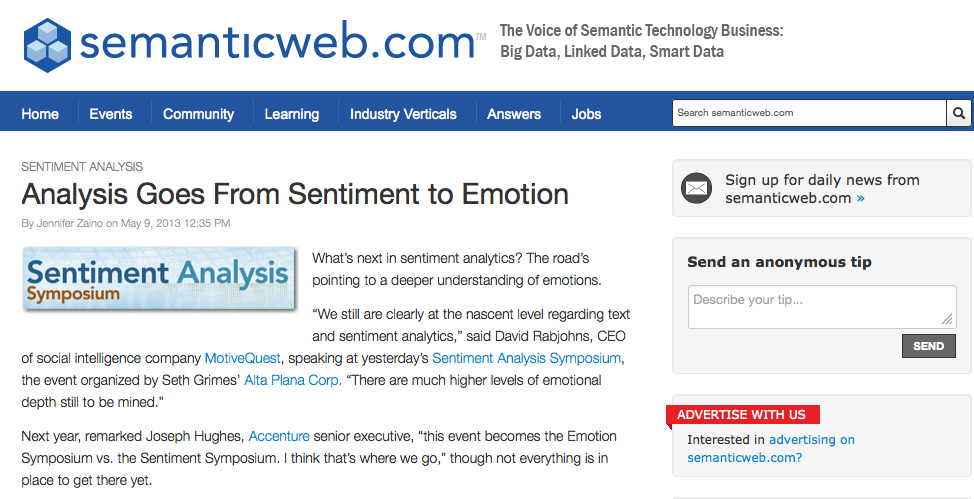Project Description
Analysis Goes From Sentiment to Emotion
By Jennifer Zaino on May 9, 2013
What’s next in sentiment analytics? The road’s pointing to a deeper understanding of emotions.
“We still are clearly at the nascent level regarding text and sentiment analytics,” said David Rabjohns, CEO of social intelligence company MotiveQuest, speaking at yesterday’s Sentiment Analysis Symposium, the event organized by Seth Grimes’ Alta Plana Corp. “There are much higher levels of emotional depth still to be mined.”
Next year, remarked Joseph Hughes, Accenture senior executive, “this event becomes the Emotion Symposium vs. the Sentiment Symposium. I think that’s where we go,” though not everything is in place to get there yet.
The steps to get there, however, can be seen in efforts like work underway at SmogFarm. “Simply dividing things into positive and negative sentiment doesn’t make sense as psychology, it’s not the whole picture,” said clinical psychologist and SmogFarm advisor Dr. Erin Olivo during her presentation at the Symposium. “There is so much more we could figure out.”
SmogFarm is aiming at that with NLP- and analytics-driven technology that can measure, track, and aggregate individual emotions to create what it calls quantitative indices of crowd psychology. Its emotional repertoire numbers 12, from the basics (liked happiness, sadness, fear, anger, and shame) that have measurable physiological and universal culturally associated adaptations (smiles or tears, for instance) to others that may be less discrete, such as contentment and confidence. Its algorithm also tracks emotional drivers – the keywords and phrases linked to the emotions being indexed.
“It gives real-time insight into what topics are driving the emotion of crowds,” she says. And that can be the pathway to determining what their attitudes about something are, to spur analysis of the impact of those attitudes on the market in question. The company is currently applying its technology to an application it’s beta-testing called KredStreet, to collect and aggregate data from trader conversations on social media outlets. Understanding that the emotion around Apple’s stock price is excitement, for instance, can equate with a bullish attitude.
And, says Olivo, “Market attitudes set prices….There’s been no analytics to quantify [those attitudes] until now.” StreetKred is slated to support features such as analyzing for bullishness or bearishness on stocks or overall market, ranking individual social traders based on their accuracy and creating news feeds to show changing sentiments on specific stocks.
Keynoter VS Subrahmanian, professor at the University of Maryland and co-founder of data science and social analytics solution Sentimetrix, which includes the emotion search engine SenteMotion in its portfolio, also spoke to the trend. He noted that the move now in the industry is to go from sentiment, with its connection to positive or negative determinations, to emotions, and discussed his team’s work around determining the intensity of different emotions on social media or other forums to help detect signals of post-traumatic stress disorder. There’s over 80 percent accuracy on individual tests, he noted.
A reason for listening to social conversations on a massive scale, pointed out Julie Wittes Schlack, senior vp of innovation and design at brand-community connector Communispace, is to understand feelings so that one can, if required, change minds and behavior. But, she cautioned, the risk “is that as soon as we try to take emotions and feelings and turn them into data and data visualizations, we run the risk of losing what’s fundamentally human beneath that data.”
So, as companies plunge deeper into understanding sentiment and even more granularly, emotions, they need to be careful about how they communicate their insights. “Data alone isn’t sufficient to move people,” she says. “People “move people.”
To view this article on Semanticweb.com, click here.






